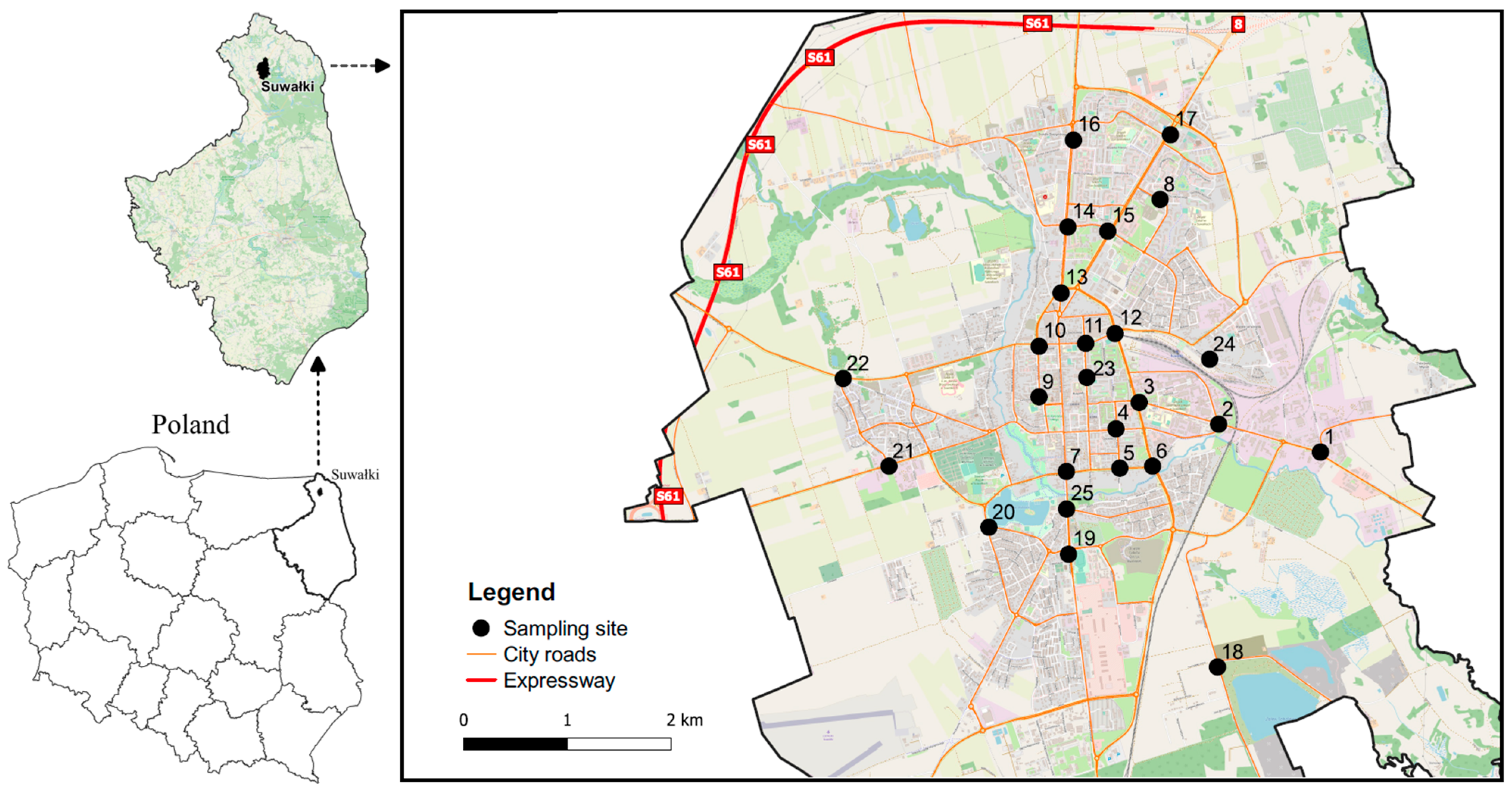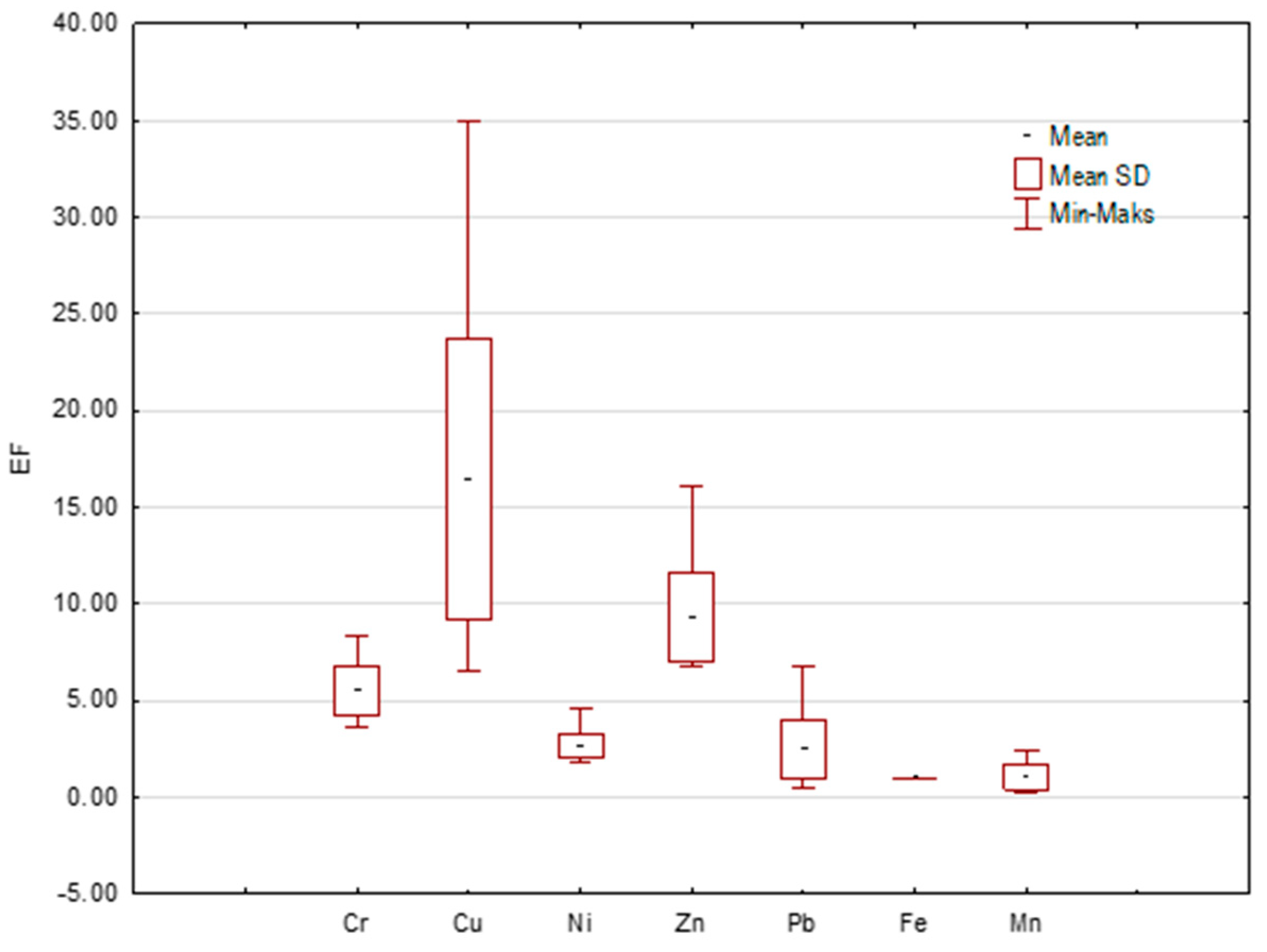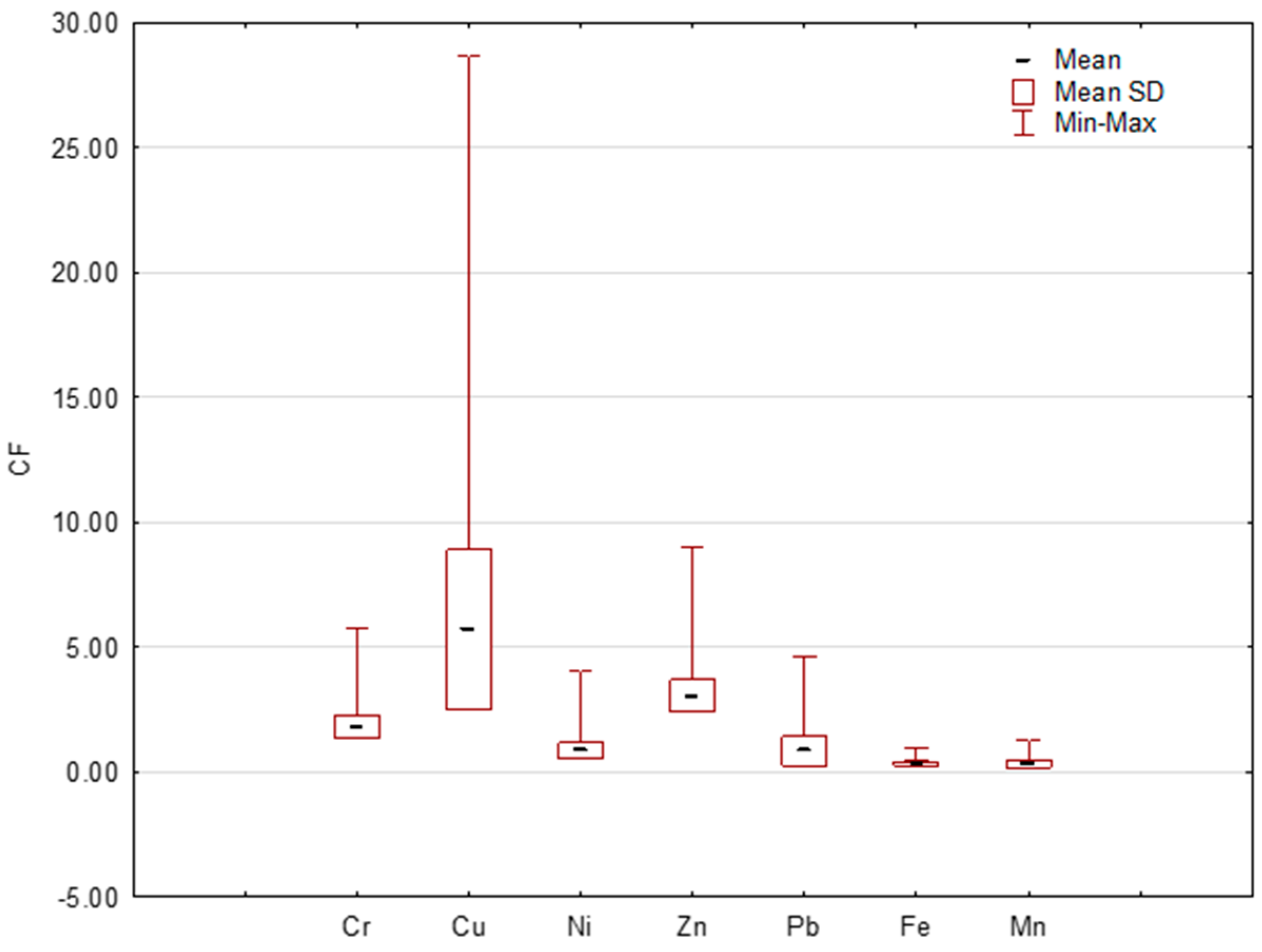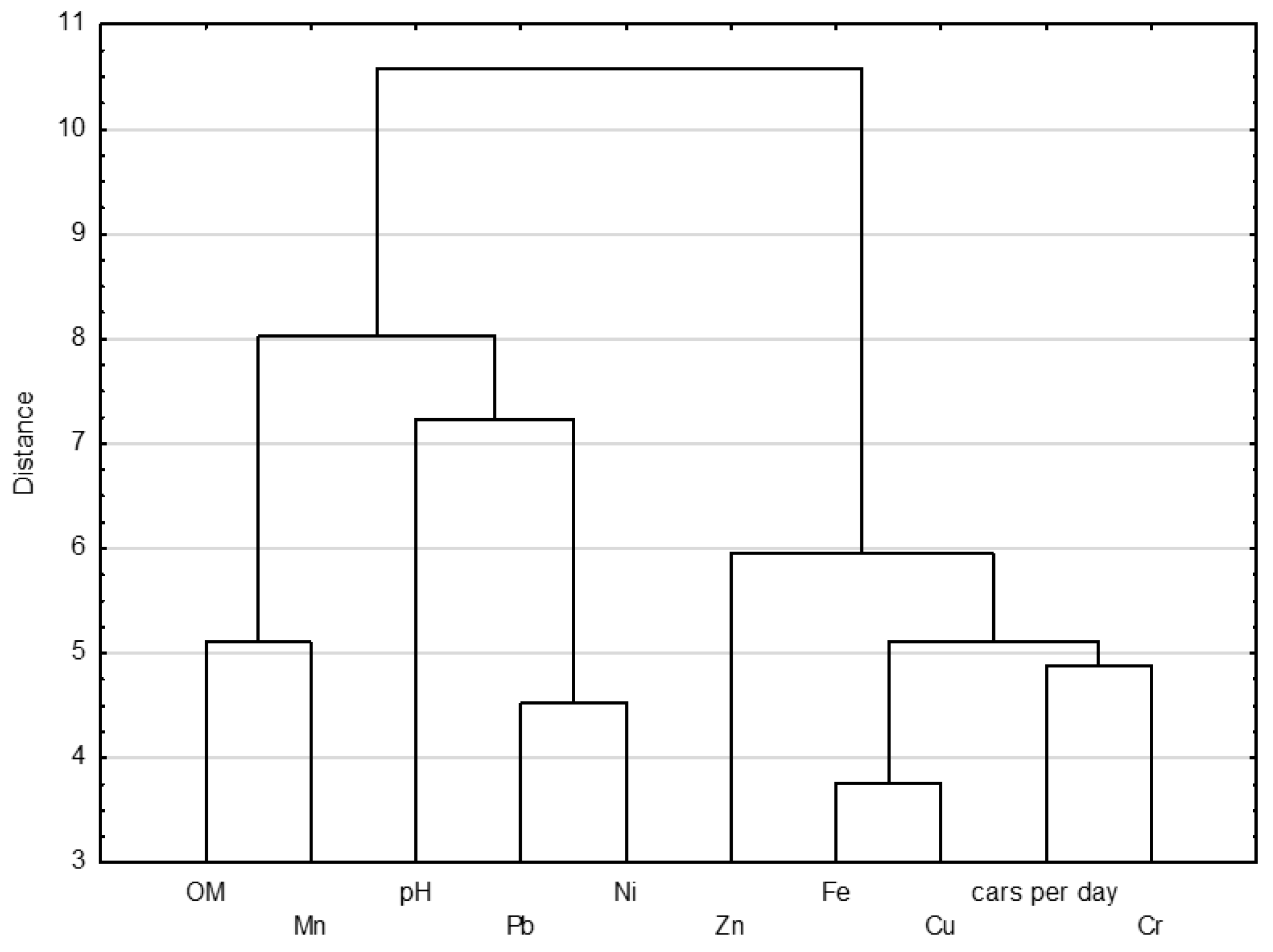Spatial Distribution and Pollution Level of Heavy Metals in Street Dust of the City of Suwałki (Poland)
Abstract
1. Introduction
2. Materials and Methods
2.1. Research Area
2.2. Sample Collection and Preparation
2.3. Analytical Methods
2.4. Statistical Analysis
2.5. Assessment of Heavy Metal Pollution
2.6. Spatial Analysis
3. Results and Discussion
3.1. Assessment of Heavy Metal Pollution of Road Dusts
3.2. Spatial Distribution of Metals in Road Dust
3.3. Identification of Pollution Sources Using Statistical Analysis
4. Conclusions
- Arithmetic averages of HM contents in dust arranged in the following order: Fe > Zn > Mn > Cu > Cr > Ni > Pb, and higher values than local background occurred for Cr, Cu, Ni, Zn, Pb;
- Values of Igeo, CF, and EF indicate that the highest pollution in dust is due to Zn and Cu are indicators of emissions from non-combustion sources and their high levels confirm the presence of these elements in many countries;
- Spatial distribution analysis indicated areas with high levels of Cr, Cu, Ni, Zn and Pb are mainly located in the central and eastern parts of the city where heavy traffic and the presence of commercial and administrative centers, bus stops dominate. The spatial distribution of Mn and Fe is different, these areas are mostly found in the eastern part of Suwałki where there is less traffic and a higher proportion of cultivated land of different nature is visible. Consequently, Fe and Mn may be partly of geogenic origin in these areas;
- Factor analysis identified two factors. The first factor correlated with Cr, Cu, Ni, Zn Pb and Fe was related to local industrial activities and the movement of motor vehicles. The second factor correlated with Mn and OM. The origin of Mn is related to motor vehicle traffic and its natural sources. The results of FA analysis were confirmed by CA analysis;
- As shown, HM contents in Suwalki road dust are lower and comparable and even in some cases higher than their contents in dust from other cities in Poland and the world. The study indicates that the sources of metals in road dust are mainly traffic emissions (car exhaust particles, tire wear particles, weathered street pavement particles, brake lining wear particles) and industrial sources (power plants, coal combustion);
- It should be emphasized that it seems advisable to introduce analysis of heavy metal content in road dust into routine monitoring studies. The research results obtained would allow the development and constant updating of guidelines for the strategy of organizing transportation in cities and the introduction, for example, of so-called low-emission zones, the operation of which has proved very successful in Stockholm, Berlin, and London, among others. Another way to reduce the migration of heavy metals is in the use of phytoremediation techniques, specifically plants referred to as hyperaccumulators. Vegetation separating roadways from sidewalks will largely contribute to the creation of natural barriers that reduce road dust emissions into the urban environment.
Author Contributions
Funding
Institutional Review Board Statement
Informed Consent Statement
Data Availability Statement
Conflicts of Interest
References
- Charlesworth, S.; Everett, M.; McCarthy, R.; Ordonez, A.; De Miguel, E. A comparative study of heavy metal concentration and distribution in deposited street dusts in a large and a small urban area: Birmingham and Coventry, West Midlands, UK. Environ. Int. 2003, 29, 563–573. [Google Scholar] [CrossRef]
- Rajaram, B.S.; Suryawanshi, P.V.; Bhanarkar, A.D.; Rao, C.V.C. Heavy metals contamination in road dust in Delhi city, India. Environ. Earth Sci. 2014, 72, 3929–3938. [Google Scholar] [CrossRef]
- Haynes, H.M.; Taylor, K.G.; Rothwell, J.; Byrne, P. Characterisation of road-dust sediment in urban systems: A review of a global challenge. J. Soils Sediments 2020, 20, 4194–4217. [Google Scholar] [CrossRef]
- Zgłobicki, W.; Telecka, M.; Skupiński, S. Assessment of short-term changes in street dust pollution with heavy metals in Lublin (E Poland)—Levels, sources and risks. Environ. Sci. Pollut. Res. 2019, 26, 35049–35060. [Google Scholar] [CrossRef]
- Zhao, H.; Li, X. Understanding the relationship between heavy metals in road-deposited sediments and washoff particles in urban stormwater using simulated rainfall. J. Hazard. Mater. 2013, 246, 267–276. [Google Scholar] [CrossRef]
- Gunawardana, C.; Egodawatta, P.; Goonetilleke, A. Role of particle size and composition in metal adsorption by solids deposited on urban road surfaces. Environ. Pollut. 2014, 184, 44–53. [Google Scholar] [CrossRef] [PubMed]
- Meza Trejo, L.M.; Quintero Nunez, M.; Valdez Salas, B. Heavy metals in urban road sediments of the city of Mexicali, Mexico. Rev. Int. Contam. Ambient. 2014, 30, 15–26. [Google Scholar]
- Zafra, C.; Temprano, J.; Tejero, I. The physical factors affecting heavy metals accumulated in the sediment deposited on road surfaces in dry weather: A review. Urban Water J. 2017, 14, 639–649. [Google Scholar] [CrossRef]
- Timmers, V.R.; Achten, P.A. Non-exhaust PM emissions from electric vehicles. Atmos. Environ. 2016, 134, 10–17. [Google Scholar] [CrossRef]
- Adamiec, E.; Jarosz-Krzemińska, E.; Wieszała, R. Heavy metals from non-exhaust vehicle emissions in urban and motorway road dusts. Environ. Monit. Assess. 2016, 188, 369. [Google Scholar] [CrossRef]
- Panko, J.M.; Chu, J.; Kreider, M.L.; Unice, K.M. Measurement of airborne concentrations of tire and road wear particles in urban and rural areas of France, Japan, and the United States. Atmos. Environ. 2013, 72, 192–199. [Google Scholar] [CrossRef]
- Chen, H.; Lu, X.; Li, L.Y.; Gao, T.; Chang, Y. Metal contamination in campus dust of Xi’an, China: A study based on multivariate statistics and spatial distribution. Sci. Total Environ. 2014, 484, 27–35. [Google Scholar] [CrossRef]
- Tokalıoğlu, Ş.; Kartal, Ş. Multivariate analysis of the data and speciation of heavy metals in street dust samples from the Organized Industrial District in Kayseri (Turkey). Atmos. Environ. 2006, 40, 2797–2805. [Google Scholar] [CrossRef]
- Yang, Z.; Lu, W.; Long, Y.; Bao, X.; Yang, Q. Assessment of heavy metals contamination in urban topsoil from Changchun City, China. J. Geochem. Explor. 2011, 108, 27–38. [Google Scholar] [CrossRef]
- Zheng, Y.; Gao, Q.; Wen, X.; Yang, M.; Chen, H.; Wu, Z.; Lin, X. Multivariate statistical analysis of heavy metals in foliage dust near pedestrian bridges in Guangzhou, South China in 2009. Environ. Earth Sci. 2013, 70, 107–113. [Google Scholar] [CrossRef]
- Christoforidis, A.; Stamatis, N. Heavy metal contamination in street dust and roadside soil along the major national road in Kavala’s region, Greece. Geoderma 2009, 151, 257–263. [Google Scholar] [CrossRef]
- Malakootian, M.; Mohammadi, A.; Nasiri, A.; Asadi, A.M.S.; Conti, G.O.; Faraji, M. Spatial distribution and correlations among elements in smaller than 75 μm street dust: Ecological and probabilistic health risk assessment. Environ. Geochem. Health 2021, 43, 567–583. [Google Scholar] [CrossRef]
- Müller, G. Schwermrttalle in den sediment des Rheins: Veranderungem seit 1971. Umschau 1979, 79, 778–783. [Google Scholar]
- Kowalska, J.B.; Mazurek, R.; Gąsiorek, M.; Zaleski, T. Pollution indices as useful tools for the comprehensive evaluation of the degree of soil contamination–A review. Environ. Geochem. Health 2018, 40, 2395–2420. [Google Scholar] [CrossRef]
- Adimalla, N.; Wang, H. Distribution, contamination, and health risk assessment of heavy metals in surface soils from northern Telangana, India. Arab. J. Geosci. 2018, 11, 684. [Google Scholar] [CrossRef]
- Muller, G. Index of geoaccumulation in sediments of the Rhine River. Geojournal 1969, 2, 108–118. [Google Scholar]
- Logiewa, A.; Miazgowicz, A.; Krennhuber, K.; Lanzerstorfer, C. Variation in the concentration of metals in road dust size fractions between 2 µm and 2 mm: Results from three metallurgical centres in Poland. Arch. Environ. Contam. Toxicol. 2020, 78, 46–59. [Google Scholar] [CrossRef]
- Mohammadi, A.; Mokhtari, M.; Arani, A.M.; Taghipour, H.; Hajizadeh, Y.; Fallahzadeh, H. Biomonitoring levels of airborne metals around Urmia Lake using deciduous trees and evaluation of their tolerance for greenbelt development. Environ. Sci. Pollut. Res. 2018, 25, 21138–21148. [Google Scholar] [CrossRef]
- Taylor, S.R. Abundance of chemical elements in the continental crust: A new table. Geochim. Cosmochim. Acta 1964, 28, 1273–1285. [Google Scholar] [CrossRef]
- Sutherland, R.A. Bed sediment-associated trace metals in an urban stream, Oahu, Hawaii. Environ. Geol. 2000, 39, 611–627. [Google Scholar] [CrossRef]
- Hakanson, L. An ecological risk index for aquatic pollution control. A sedimentological approach. Water Res. 1980, 14, 975–1001. [Google Scholar] [CrossRef]
- Loska, K.; Wiechuła, D.; Korus, I. Metal contamination of farming soils affected by industry. Environ. Int. 2004, 30, 159–165. [Google Scholar] [CrossRef] [PubMed]
- Hayrat, A.; Eziz, M. Identification of the spatial distributions, pollution levels, sources, and health risk of heavy metals in surface dusts from Korla, NW China. Open Geosci. 2020, 12, 1338–1349. [Google Scholar] [CrossRef]
- Xu, H.; Wang, Y.; Liu, R.; Wang, M.; Zhang, Y. Spatial distribution, chemical speciation and health risk of heavy metals from settled dust in Qingdao urban area. Atmosphere 2019, 10, 73. [Google Scholar] [CrossRef]
- Shandilya, K.K.; Khare, M.; Gupta, A.B. Organic matter determination for street dust in Delhi. Environ. Monit. Assess. 2013, 185, 5251–5264. [Google Scholar] [CrossRef] [PubMed]
- Robertson, D.J.; Taylor, K.G.; Hoon, S.R. Geochemical and mineral magnetic characterisation of urban sediment particulates, Manchester, UK. Appl. Geochem. 2003, 18, 269–282. [Google Scholar] [CrossRef]
- Shilton, V.F.; Booth, C.A.; Smith, J.P.; Giess, P.; Mitchell, D.J.; Williams, C.D. Magnetic properties of urban street dust and their relationship with organic matter content in the West Midlands, UK. Atmos. Environ. 2005, 39, 3651–3659. [Google Scholar] [CrossRef]
- O’Shea, M.J.; Vann, D.R.; Hwang, W.T.; Gieré, R. A mineralogical and chemical investigation of road dust in Philadelphia, PA, USA. Environ. Sci. Pollut. Res. 2020, 27, 14883–14902. [Google Scholar] [CrossRef] [PubMed]
- Czarnowska, K. Ogólna zawartość metali ciężkich w skałach macierzystych jako tło geochemiczne gleb. Rocz. Glebozn. 1996, 47, 43–50. [Google Scholar]
- Taylor, S.R.; McLennan, S.M. The Continental Crust: Its Composition and Evolution; Blackwell Scientific Publications: Hoboken, NJ, USA, 1985. [Google Scholar]
- Karim, Z.; Qureshi, B.A.; Mumtaz, M.; Qureshi, S. Heavy metal content in urban soils as an indicator of anthropogenic and natural influences on landscape of Karachi—A multivariate spatio-temporal analysis. Ecol. Indic. 2014, 42, 20–31. [Google Scholar] [CrossRef]
- Pan, H.; Lu, X.; Lei, K. A comprehensive analysis of heavy metals in urban road dust of Xi’an, China: Contamination, source apportionment and spatial distribution. Sci. Total Environ. 2017, 609, 1361–1369. [Google Scholar] [CrossRef]
- Zhang, C.; Fay, D.; McGrath, D.; Grennan, E.; Carton, O.T. Statistical analyses of geochemical variables in soils of Ireland. Geoderma 2008, 146, 378–390. [Google Scholar] [CrossRef]
- De Andrade, L.C.; Tiecher, T.; de Oliveira, J.S.; Andreazza, R.; Inda, A.V.; De Oliveira Camargo, F.A. Sediment pollution in margins of the Lake Guaíba, Southern Brazil. Environ. Monit. Assess. 2018, 190, 3. [Google Scholar] [CrossRef]
- Smolders, E.; Degryse, F. Fate and effect of zinc from tire debris in soil. Environ. Sci. Technol. 2002, 36, 3706–3710. [Google Scholar] [CrossRef]
- Davis, A.P.; Shokouhian, M.; Ni, S. Loading estimates of lead, copper, cadmium, and zinc in urban runoff from specific sources. Chemosphere 2001, 44, 997–1009. [Google Scholar] [CrossRef]
- Schauer, J.J.; Lough, G.C.; Shafer, M.M.; Christensen, W.F.; Arndt, M.F.; DeMinter, J.T.; Park, J.S. Characterization of metals emitted from motor vehicles. Res. Rep. Health Eff. Inst. 2006, 133, 1–76. [Google Scholar]
- Lu, X.; Wang, L.; Li, L.Y.; Lei, K.; Huang, L.; Kang, D. Multivariate statistical analysis of heavy metals in street dust of Baoji, NW China. J. Hazard. Mater. 2010, 173, 744–749. [Google Scholar] [CrossRef]
- Dytłow, S.; Górka-Kostrubiec, B. Concentration of heavy metals in street dust: An implication of using different geochemical background data in estimating the level of heavy metal pollution. Environ. Geochem. Health 2021, 43, 521–535. [Google Scholar] [CrossRef]
- Wang, C.F.; Chang, C.Y.; Tsai, S.F.; Chiang, H.L. Characteristics of road dust from different sampling sites in northern Taiwan. J. Air Waste Manag. Assoc. 2005, 55, 1236–1244. [Google Scholar] [CrossRef] [PubMed]
- Amato, F.; Pandolfi, M.; Viana, M.; Querol, X.; Alastuey, A.; Moreno, T. Spatial and chemical patterns of PM10 in road dust deposited in urban environment. Atmos. Environ. 2009, 43, 1650–1659. [Google Scholar] [CrossRef]
- De Miguel, E.; Llamas, J.F.; Chacón, E.; Berg, T.; Larssen, S.; Røyset, O.; Vadset, M. Origin and patterns of distribution of trace elements in street dust: Unleaded petrol and urban lead. Atmos. Environ. 1997, 31, 2733–2740. [Google Scholar] [CrossRef]
- Rasmussen, P.E.; Subramanian, K.S.; Jessiman, B.J. A multi-element profile of house dust in relation to exterior dust and soils in the city of Ottawa, Canada. Sci. Total Environ. 2001, 267, 125–140. [Google Scholar] [CrossRef]
- Kiebała, A.; Kozieł, M.; Zgłobicki, W. Cr, Cu, Ni, Pb i Zn w pyle drogowym na terenie Lublina. Inżynieria Ochr. Sr. 2015, 18, 299–310. [Google Scholar]
- Kozanecka, D.; Kozanecki, Z.; Lech, T.; Świder, P. New concept of the spin test system with active magnetic bearings. In Proceedings of the 2nd International Symposium on Stability Control of Rotating Machinery, Gdańsk, Poland, 4–8 August 2003; pp. 199–208. [Google Scholar]
- Skorbiłowicz, M.; Skorbiłowicz, E.; Łapiński, W. Assessment of Metallic Content, Pollution, and Sources of Road Dust in the City of Białystok (Poland). Aerosol Air Qual. Res. 2020, 20, 2507–2518. [Google Scholar] [CrossRef]
- Ghazaryan, K.A.; Gevorgyan, G.A.; Movsesyan, H.S.; Ghazaryan, N.P.; Grigoryan, K.V. The evaluation of heavy metal pollution degree in the soils around the Zangezur Copper and Molybdenum Combine. Int. J. Environ. Ecol. Eng. 2015, 9, 422–427. [Google Scholar]
- Yuen, J.Q.; Olin, P.H.; Lim, H.S.; Benner, S.G.; Sutherland, R.A.; Ziegler, A.D. Accumulation of potentially toxic elements in road deposited sediments in residential and light industrial neighborhoods of Singapore. J. Environ. Manag. 2012, 101, 151–163. [Google Scholar] [CrossRef] [PubMed]
- Mohamed, T.A.; Mohamed, M.A.K.; Rabeiy, R.; Ghandour, M.A. Application of pollution indices for evaluation of heavy metals in soil close to phosphate fertilizer plant, Assiut, Egypt. Assiut Univ. Bull. Environ. Res. 2014, 17, 45–55. [Google Scholar]
- Inengite, A.K.; Abasi, C.Y.; Walter, C. Application of pollution indices for the assessment of heavy metal pollution in flood impacted soil. Int. Res. J. Pure Appl. Chem. 2015, 8, 175–189. [Google Scholar] [CrossRef]
- Hassan, S.K.M. Metal concentrations and distribution in the household, stairs and entryway dust of some Egyptian homes. Atmos. Environ. 2012, 54, 207–215. [Google Scholar] [CrossRef]
- López, M.L.; Ceppi, S.; Palancar, G.G.; Olcese, L.E.; Tirao, G.; Toselli, B.M. Elemental concentration and source identification of PM10 and PM2.5 by SR-XRF in Córdoba City, Argentina. Atmos. Environ. 2011, 45, 5450–5457. [Google Scholar] [CrossRef]
- Jeong, H.; Choi, J.Y.; Ra, K. Potentially toxic elements pollution in road deposited sediments around the active smelting industry of Korea. Sci. Rep. 2021, 11, 7238. [Google Scholar] [CrossRef]
- Yongming, H.; Peixuan, D.; Junji, C.; Posmentier, E.S. Multivariate analysis of heavy metal contamination in urban dusts of Xi’an, Central China. Sci. Total Environ. 2006, 355, 176–186. [Google Scholar] [CrossRef]






| Parameter | N | G.b. 1 | G.b. 2 | Average | Min | Max | SD | CV [%] | Shapiro–Wilk Test |
|---|---|---|---|---|---|---|---|---|---|
| Cr | 25 | 27.00 | 35.00 | 63.59 | 35.06 | 102.21 | 16.88 | 26.54 | 0.53 |
| Cu | 25 | 7.10 | 25.00 | 142.84 | 40.39 | 366.05 | 79.46 | 55.63 | 0.04 |
| Ni | 25 | 10.20 | 20.00 | 17.50 | 11.46 | 41.56 | 5.92 | 33.80 | 0.00 |
| Zn | 25 | 30.00 | 71.00 | 215.97 | 129.20 | 325.26 | 46.02 | 21.31 | 0.97 |
| Pb | 25 | 9.80 | 20.00 | 17.04 | 2.71 | 47.32 | 11.69 | 68.57 | 0.00 |
| Fe | 25 | 12,900.00 | 35,000.00 | 11,692.80 | 7828.72 | 17,393.52 | 2333.38 | 19.96 | 0.54 |
| Mn | 25 | 289.00 | 600.00 | 194.78 | 63.68 | 397.33 | 101.71 | 52.22 | 0.02 |
| OM | 25 | - | - | 2.24 | 0.70 | 7.90 | 1.53 | 68.33 | 0.00 |
| pH | 25 | - | - | - | 7.31 | 8.77 | - | - | |
| cars per day | 25 | - | - | 3328.72 | 650.00 | 8358.00 | 2172.59 | 65.27 | 0.01 |
| City | Population | Zn | Cu | Pb | Ni | Cr | Mn | Fe | Reference |
|---|---|---|---|---|---|---|---|---|---|
| Birmingham (Anglia) | 2300,000.00 | 534.00 | 466.90 | 48.00 | 41.10 | - | - | - | [1] |
| Madrid (Hiszpamia) | 2,909,792.00 | 476.00 | 188.00 | 1927.00 | 44.00 | 61.00 | 362.00 | 19,300.00 | [47] |
| Kavala (Grecja) | 54,027.00 | 272.00 | 124.00 | 301.00 | 58.00 | 196.00 | - | - | [16] |
| Ottawa (Kanada) | 934,240.00 | 101.00 | 38.10 | 33.50 | 14.80 | 41.70 | - | - | [48] |
| Lublin (Polska) | 341,975.00 | 201.80 | 65.70 | 23.30 | 26.80 | 52.80 | - | - | [49] |
| Warszawa (Polska) | 1,735,000.00 | 63.60 | 30.60 | 33.85 | 10.31 | - | 134.10 | 600.00 | [50] |
| Białystok (Polska) | 294,153.00 | 68.99 | 16.37 | 11.42 | 5.20 | 9.12 | 68.62 | 2335.00 | [51] |
| Suwałki (Polska) | 70,000.00 | 215.97 | 142.84 | 17.04 | 17.50 | 63.59 | 194.78 | 11,692.80 | W tym badaniu |
| Cr | Cu | Ni | Zn | Pb | Fe | Mn | OM | pH | Cars per Day | |
|---|---|---|---|---|---|---|---|---|---|---|
| Cr | 1.00 | |||||||||
| Cu | 0.58 | 1.00 | ||||||||
| Ni | 0.30 | 0.44 | 1.00 | |||||||
| Zn | 0.31 | 0.54 | 0.20 | 1.00 | ||||||
| Pb | 0.15 | 0.50 | 0.57 | 0.36 | 1.00 | |||||
| Fe | 0.53 | 0.71 | 0.58 | 0.35 | 0.45 | 1.00 | ||||
| Mn | −0.18 | −0.08 | 0.15 | 0.09 | 0.22 | −0.18 | 1.00 | |||
| OM | −0.13 | −0.05 | −0.00 | 0.18 | 0.10 | −0.06 | 0.46 | 1.00 | ||
| pH | −0.25 | 0.09 | 0.13 | −0.08 | 0.07 | −0.16 | 0.22 | −0.13 | 1.00 | |
| cars per day | 0.50 | 0.64 | 0.06 | 0.32 | 0.22 | 0.38 | −0.34 | −0.09 | −0.01 | 1.00 |
| Factor 1 | Factor 2 | |
|---|---|---|
| Cr | 0.63 | −0.43 |
| Cu | 0.89 | −0.16 |
| Ni | 0.67 | 0.28 |
| Zn | 0.63 | 0.10 |
| Pb | 0.70 | 0.37 |
| Fe | 0.81 | −0.19 |
| Mn | 0.02 | 0.85 |
| OM | 0.05 | 0.61 |
| pH | −0.01 | 0.32 |
| cars per day | 0.57 | −0.49 |
| % of variance | 35 | 19 |
Disclaimer/Publisher’s Note: The statements, opinions and data contained in all publications are solely those of the individual author(s) and contributor(s) and not of MDPI and/or the editor(s). MDPI and/or the editor(s) disclaim responsibility for any injury to people or property resulting from any ideas, methods, instructions or products referred to in the content. |
© 2023 by the authors. Licensee MDPI, Basel, Switzerland. This article is an open access article distributed under the terms and conditions of the Creative Commons Attribution (CC BY) license (https://creativecommons.org/licenses/by/4.0/).
Share and Cite
Skorbiłowicz, M.; Trybułowski, Ł.; Skorbiłowicz, E. Spatial Distribution and Pollution Level of Heavy Metals in Street Dust of the City of Suwałki (Poland). Int. J. Environ. Res. Public Health 2023, 20, 4687. https://doi.org/10.3390/ijerph20064687
Skorbiłowicz M, Trybułowski Ł, Skorbiłowicz E. Spatial Distribution and Pollution Level of Heavy Metals in Street Dust of the City of Suwałki (Poland). International Journal of Environmental Research and Public Health. 2023; 20(6):4687. https://doi.org/10.3390/ijerph20064687
Chicago/Turabian StyleSkorbiłowicz, Mirosław, Łukasz Trybułowski, and Elżbieta Skorbiłowicz. 2023. "Spatial Distribution and Pollution Level of Heavy Metals in Street Dust of the City of Suwałki (Poland)" International Journal of Environmental Research and Public Health 20, no. 6: 4687. https://doi.org/10.3390/ijerph20064687
APA StyleSkorbiłowicz, M., Trybułowski, Ł., & Skorbiłowicz, E. (2023). Spatial Distribution and Pollution Level of Heavy Metals in Street Dust of the City of Suwałki (Poland). International Journal of Environmental Research and Public Health, 20(6), 4687. https://doi.org/10.3390/ijerph20064687






